Best Value
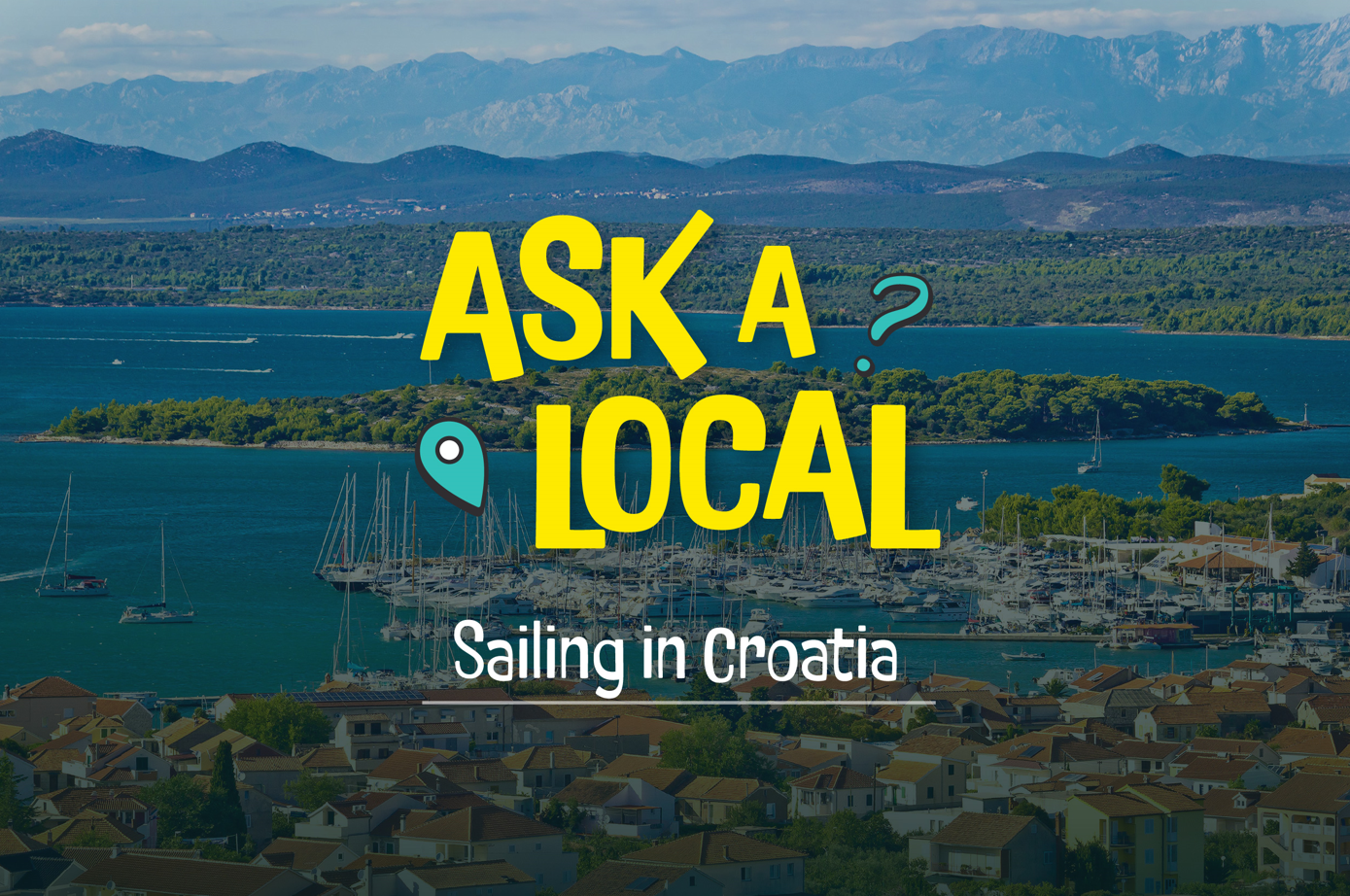
Ask A Local: Sailing Croatia - A Local’s 6-Day Route Through The Adriatic
In this post...
- When to set sail
- How to get a boat
- The 6-day route
- Day 1: Sail alongside dolphins towards the best hilltop view on the island of Žut
- Day 2: Easy cruise towards little-known gem – Veli Iž
- Day 3: Explore old warship hideouts, shipwrecks, and Sakarun beach
- Day 4: Cliffs of Dugi Otok
- Day 5: Through Kornati National Park
- Day 6: Back to Biograd… with a twist
- Tools & Resources
At Sim Local, our team is spread out across the world, giving us a unique insider perspective in lots of places arounds the world. This series shares tips you won’t find in guidebooks—straight from the people who live there. Set sail with us—this week, we’re island hopping through Croatia’s best sailing spots with Tech Lead Gordan Krešić!
Did you know that around 40% of the world's nautical charter fleet is located in Croatia, one of the smallest European countries?
While surprising at first, it makes a lot more sense once you look at the map: Croatia lies along the north-eastern coast of the Adriatic Sea—a closed, shallow, and thus quite calm body of water scattered with hundreds of islands, many of which are inhabited.
Its latitude plays a role too, putting it in a sort of "nautical Goldilocks zone": for most of the year, it's neither too cold nor too hot, with just enough wind to properly enjoy easy sailing. Put all that together and you get a perfect playground for what locals call "đita" (pronounced "ji·ta")—meaning "sailing without any particular destination, island hopping".
Pick your starting port, plan something based on the weather forecast, and get lost for a week.
The best part is that you can start from pretty much anywhere on the Adriatic, as the coastline is more or less uniform from the Istria Peninsula in the north all the way to Dubrovnik in the south.
And while the southern Adriatic—with its large islands (Šolta, Brač, Hvar, Vis, Korčula)—is by far the most popular nautical destination during the peak season in July and August, I’d like to recommend something a bit different.
When to set sail
First of all, try to avoid sailing in July and August if you possibly can. It’s way too hot to be on a boat during those months (locals call it “tourist barbecue”, not without reason), there’s rarely any wind (so you’ll have to motor most of the way), and most of the anchorages, ports, and marinas are overcrowded—often forcing you to shorten your daily route just so you can arrive early enough to still find a free spot for the night.
The best places can fill up as early as 2 PM—this is a direct consequence of having a large number of boats in a relatively small area.
Instead, I recommend targeting (early) September, when there are fewer crowds and more wind, but the sea is still warm enough for a swim. Optionally, if you’re more into sailing and less into swimming, you can also go for May, when you’re almost guaranteed enough wind to enjoy your rigging to the fullest.
Ideally, of course, you’d aim for both May and September—but that’s another story 🙂.
As for location, my proposal is to substitute the southern Adriatic for the central one, where there are far more islands to explore—as well as one of Croatia’s two maritime national parks: Kornati.
How to get a boat
Most of the charter companies in Croatia will rent you a boat on a fixed schedule: Saturday to Saturday. Sometimes, at the very beginning or end of the season, you might be able to negotiate a shorter stay, but for most of the season, you’ll be stuck with a Saturday–Saturday deal.
This, in fact, isn’t without reason, as that schedule allows charter companies to effectively operate only on Saturdays—taking over the boat from the previous crew and preparing it for the next—with most other days requiring only an on-call mechanic in the office.

Central Adriatic Grand Tour: Over 100 nautical miles in 6 days. (source: Google My Maps)
The 6-day route
This is my favourite 6-day sailing trip: the Central Adriatic Grand Tour!
Bear in mind that this is just my suggestion—you’re free to modify the route however you like. Some may prefer shorter legs with more time on the beaches or exploring the islands rather than on the boat, and luckily, that’s perfectly doable along this route.
At any point, you’ll be no more than an hour or two away from your next potential stop. Also, always keep an eye on the weather forecast, as wind direction and sea conditions should always take precedence over any plans made while sitting on your sofa at home.
My proposed route starts in Biograd, where you’ll find one of the largest marinas on the Adriatic—Marina Kornati—home to a large charter fleet, so booking a boat here will be a piece of cake (check the end of the article for some links to get you started).
As I’ve already mentioned, whichever charter you choose, you’ll probably arrive in Biograd on Saturday evening. Although there are usually options to pay extra for early boarding, I’d actually advise the opposite: after you arrive and finish registration at the charter office, take over your boat—but don’t sail away immediately.
Instead, get to know your boat, stock it properly for a week at sea (there’s a big convenience store just outside the marina—check the map provided), and once you’ve got everything prepped for an early departure tomorrow morning—hit the town!
Biograd is a lovely little place, extremely walkable and quite charming, with plenty of restaurants and bars to keep you busy well into the night. So enjoy yourself, but don’t overdo it—you’ve still got an early start in the morning!
If you’re arriving by car, instead of parking in the marina, try asking around at the houses just north of the marina—they’ll often offer you a spot for a fraction of the price you’d normally pay inside.
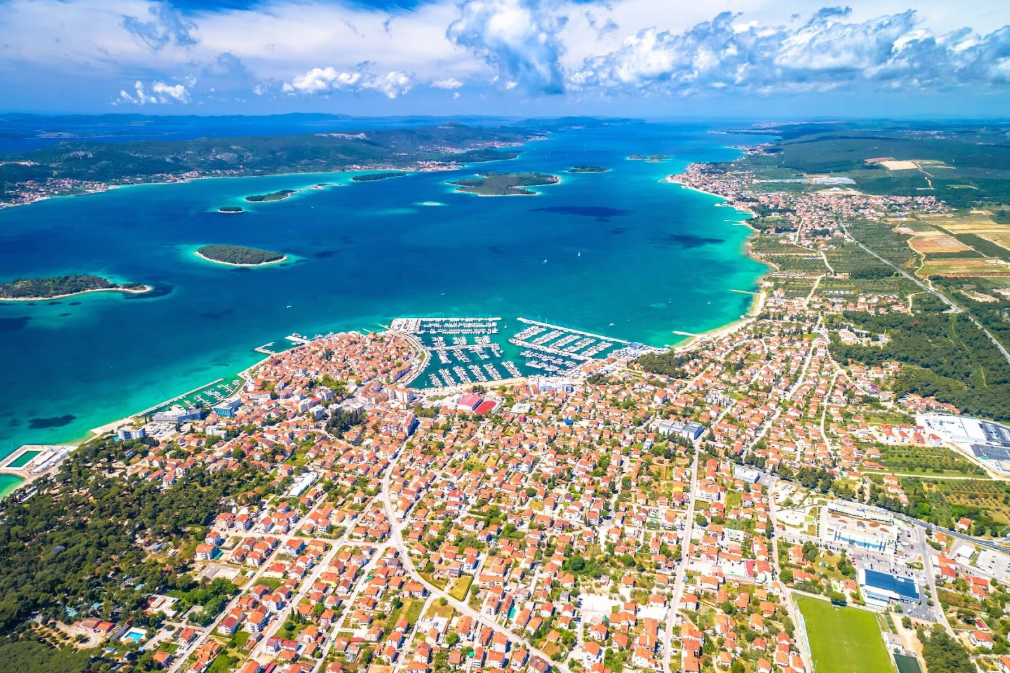
Biograd, its huge nautical marina and surrounding archipelago (source: EuroYacht.hr)
Day 1: Sail alongside dolphins towards the best hilltop view on the island of Žut
Distance: 20 NM
Sunday morning in the marina won’t be very busy, so you shouldn’t have any trouble manoeuvring your way out and heading south. In this part of the Adriatic, there aren’t any underwater surprises, so you can set sail straight after exiting the marina and chart any course you like around the island of Pašman.
After leaving Pašman to starboard, turn south-west towards the southern tip of the island of Žut.
There are at least two reasons why I recommend the longer route here, passing Žut from the south-western side. First, the sea to the north-east of Žut has plenty of small islands and rocks—not all of which are clearly visible (though they are very well marked on all nautical charts).
Of course, none of that should pose a challenge for a skilled skipper, but my assumption is that you’re here on holiday, not practising navigation and tight turns.
And there’s another reason to choose this route: the passage between Žut and Veliki Kornat is a natural habitat for common bottlenose dolphins, and it’s quite common to spot them here, jumping about or swimming alongside your boat.
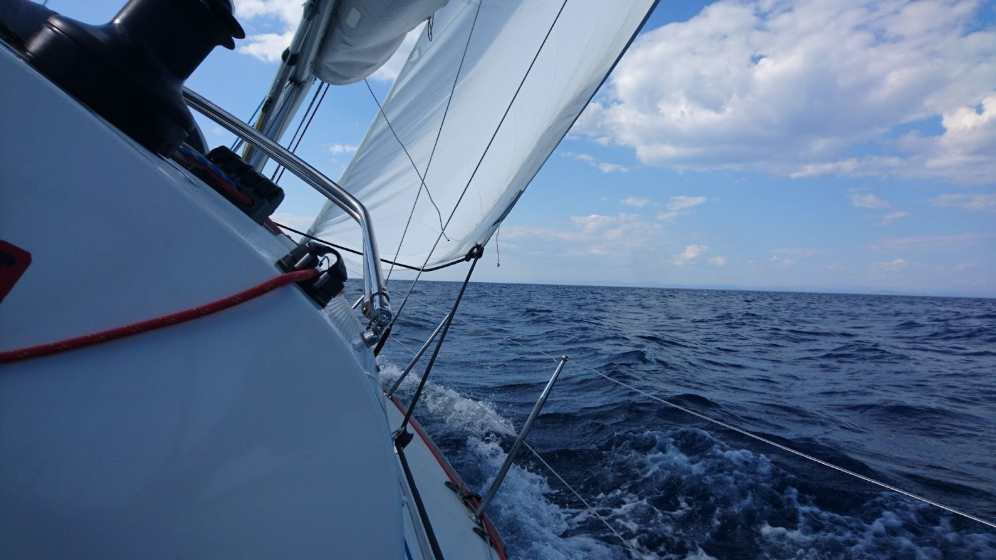
Sail all the way to the end of Žut, round the island, and then head into a large bay where you’ll find the small and cosy ACI Marina Žut—a lovely spot for your first night at sea.
Marina Žut is unique in many ways: it’s quite small and simple (just one long pontoon) with a strong “Robinson Crusoe” vibe. Don’t expect much here—beyond basic marina facilities (water, electricity, showers), there’s only one small shop and a (not-so-spectacular) restaurant.
However, this is also the only marina in the Adriatic where, after docking my boat, I immediately walk three metres to the other side of the pontoon and—jump in for a swim. Yep, the water is that clean!
One more thing makes a stop at Žut absolutely worth it: the view from a nearby hilltop. It’ll take you 20–30 minutes to climb, but if you make the effort and catch the sunset from the top, you’re almost guaranteed to return someday. You’ve been warned!
As I mentioned, the restaurant at the marina is average at best. Nearby Fešta is much better—but also much pricier. Bear in mind that this is, in essence, an uninhabited island, which makes running a restaurant here quite a challenge.
The final culinary decision is up to you. When we're on Žut, we usually cook something onboard.
Hint: Due to its shape, the marina is excellent for docking practice. If I’m sailing with someone who’s still learning, we always use the next morning—after most other boats have left—for an hour of docking practice. Just remember to be polite and ask the marina staff for permission first.
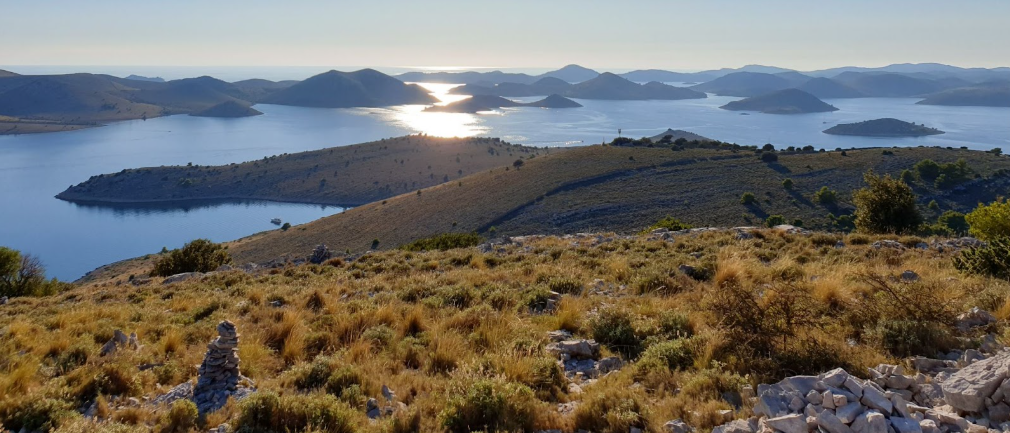
View from the hilltop just above ACI marina Žut (source: private archive)
Day 2: Easy cruise towards little-known gem – Veli Iž
Distance: 15 NM
The next day is navigationally quite simple: you’ll be sailing almost in a straight line, with few islands along the way (just make sure to avoid the fish farms, which are marked with yellow buoys).
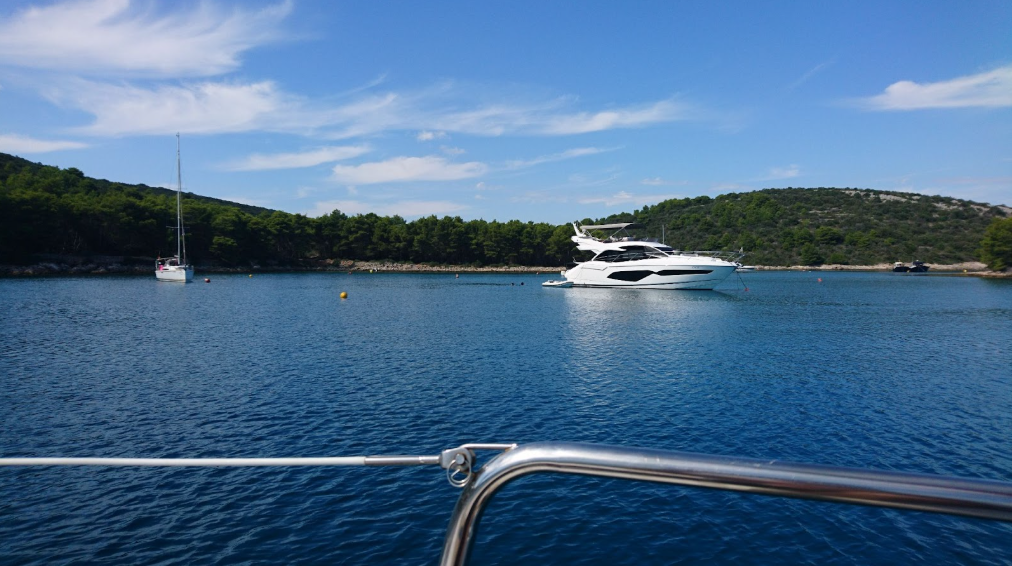
Vodenjak Bay: Never miss an opportunity for a nice afternoon swim (source: private archive)
If you’re lucky, you’ll get a decent wind, making this passage both a joy and a breeze. And if you enjoy sailing, there’s always the option to tack back and forth along the route—especially if you’re sailing in a group with a couple of boats. In that case, it’s practically a regatta!
If it’s a hot day, a great opportunity for a swim comes as soon as you reach the island of Iž, at Vodenjak Bay. The anchorage has a few buoys you can tie to, but it’s not very large, so there’s a chance you’ll have to anchor.
Unfortunately, the seabed isn’t clear of rocks, so be careful where you drop anchor—you may have to dive to free it. Luckily, the bay is quite shallow (5–7 metres), so that shouldn’t be too much of an issue.
Whenever you’re ready to call it a day, head over to Veli Iž—your destination for the night. Veli Iž Bay is shallow overall, so manoeuvre carefully as you enter.
That said, the marina is well set up, and you can dock almost anywhere—even with a draught of over 2 metres. The marina staff will guide you to a safe spot.
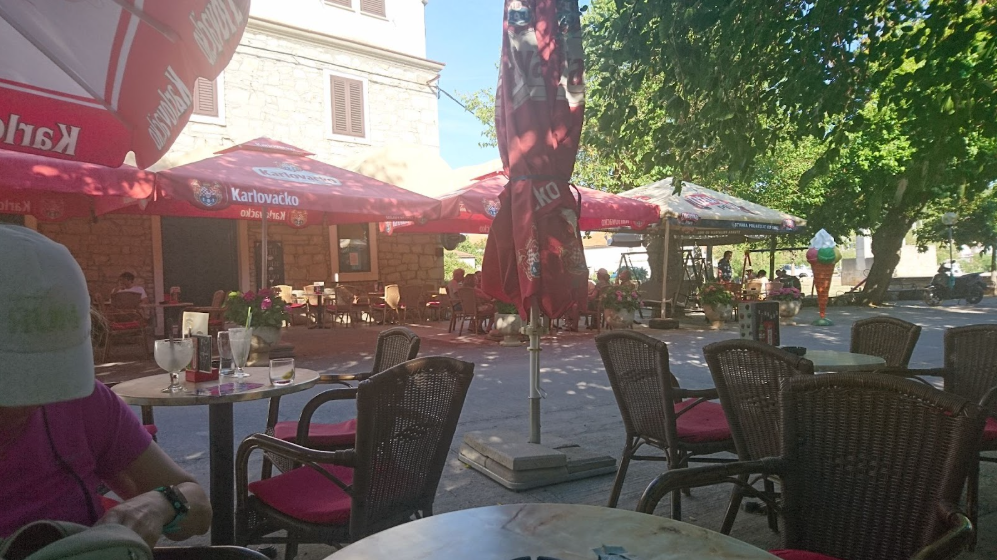
Veli Iž: Authentic Croatian "island vibe" (source: private archive)
Veli Iž is an old fishing village—both picturesque and slightly avant-garde at the same time. Take your time and have a wander. I never visit Veli Iž without stopping for a coffee and ice cream at Caffe Bar Slanac.
And if you cooked onboard last night, Veli Iž is a great place to hunt down a cosy tavern serving fresh fish.
Before setting off in the morning, don’t forget to top up your water tank(s)—you may be away from civilisation for the remainder of the week.
Day 3: Explore old warship hideouts, shipwrecks, and Sakarun beach
Distance: 22 NM
Properly rested from the day (and evening) before, you should now be ready for one of the two longest legs of the week. Today is all about exploration. After exiting Veli Iž Bay, head northwest into the channel between Dugi Otok and Zverinac islands.
Just after passing Božava on Dugi Otok, you’ll spot a relic from a more militarised time—a warship hideout, carved deep into the rocks of Dugi Otok. Now abandoned, it’s still a fascinating place to visit.
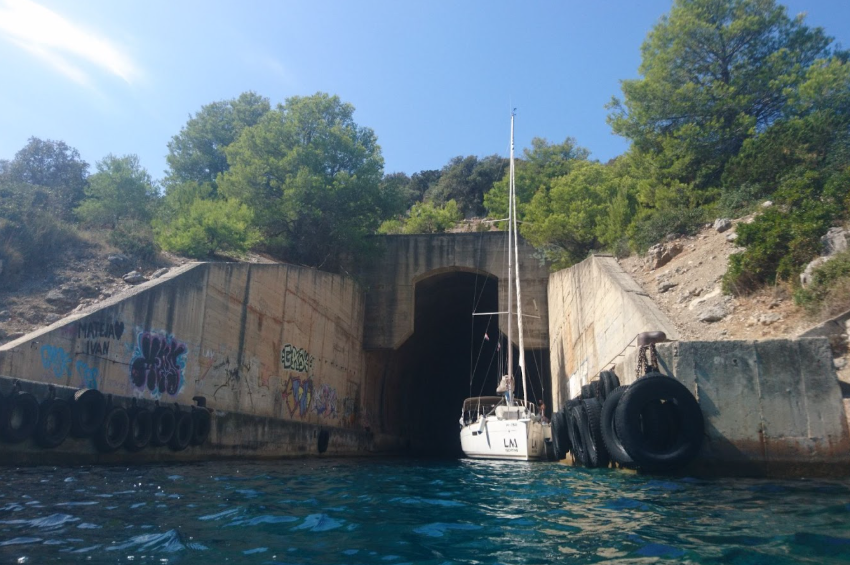
Abandoned warship hideout (source: private archive)
You can dock on either side of the tunnel, but keep an eye on the wind when entering, as it can unexpectedly shift direction. If you’re alone, there will probably be enough room to manoeuvre, but if other boats are already docked, be polite and don’t force your way in unless you’re confident you can do so safely.
Once inside, if you’re feeling adventurous, grab a headlamp and explore the inner corridors and infrastructure buried deep in the island.
After you’ve had your fill of this rusty relic, it’s time to visit the next one. Just after rounding Dugi Otok, you’ll find yourself near the most interesting shipwreck in the entire Adriatic—Michelle.
Drop anchor to the (north)east of it and take a dinghy (or swim) over. The wreck sits right at sea level—which is part of what makes it so fascinating—so approach with caution, especially if there are even slight waves. It’s not uncommon for someone to end their holiday early thanks to a nasty cut on rusted steel.
Finally, leave all that history behind and head towards the Sveti Rat lighthouse—one of the largest on the Adriatic. Leave it to port and continue towards one of the best sandy beaches in the region: Sakarun. There, you’ll find plenty of buoys waiting.
Pick one close to shore and swim to the beach (don’t use the dinghy, especially if there are people already on the beach).
Close the day with a meal prepared while the boat gently sways in the bay.
If you’ve been following this suggested route, this will be your first night outside a marina—so it’s a good time to remind you to use your holding (waste) tank.
Although every charter boat registered in Croatia in the last ten years is legally required to have one, many charter companies quietly advise against using it. The main reason is maintenance, but the lack of proper infrastructure for emptying them doesn’t help either.
So far, you’ve spent your nights in marinas where toilets were available. But while at anchor, it’s just you and the sea. And you probably don’t want to wake up to find yesterday’s “business” floating around—especially if someone in your crew likes a morning swim.
So don’t forget to engage the holding tank whenever docked, moored, or anchored—and empty it responsibly once you’re away from shore (unfortunately, there’s no better option).
A word of warning
The suggested route for the next day will take you along the outer side of Dugi Otok, fully exposed to open sea, with no shelter in case of trouble. So watch the weather forecast closely.
If it looks like the next day won’t be suitable for sailing on the exposed side (seasickness is never fun), skip Sakarun and head to Pantera Bay instead. You’ll be safe there even at anchor, and for extra peace of mind, there’s a small marina just outside Veli Rat.
The following day, you can then decide which side of Dugi Otok to sail back along.
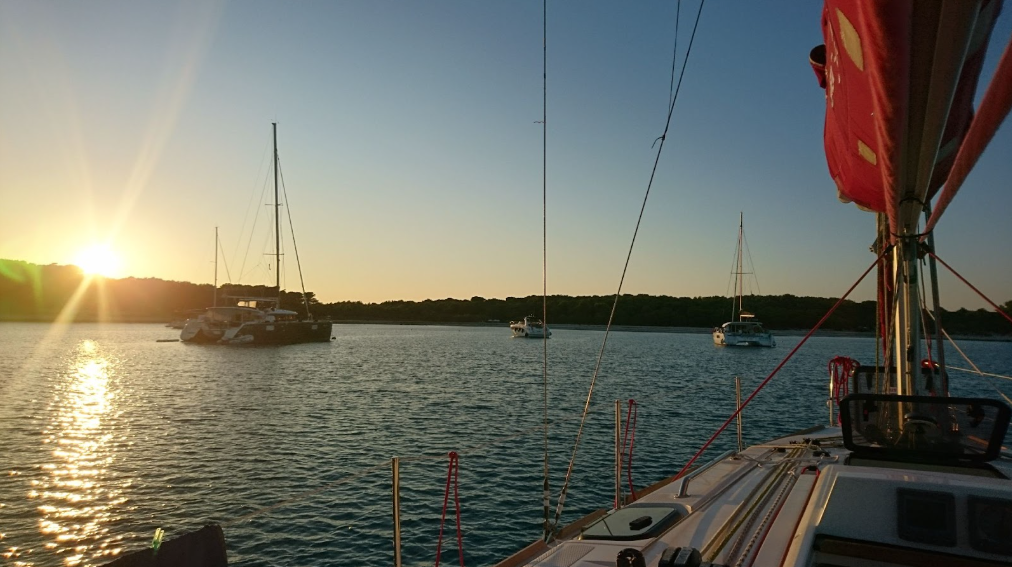
Sunset on Sakarun beach (source: private archive)
Day 4: Cliffs of Dugi Otok
Distance: 25 NM
Ready for the longest leg of this Grand Tour?
With 25 nautical miles planned for today (possibly more, depending on where you choose to stop—more on that later) and almost no way to shorten it, today won’t be your chance to sleep in. The outer side of Dugi Otok is stunning but also rather inhospitable and completely uninhabited, so it’s best to make an early start.
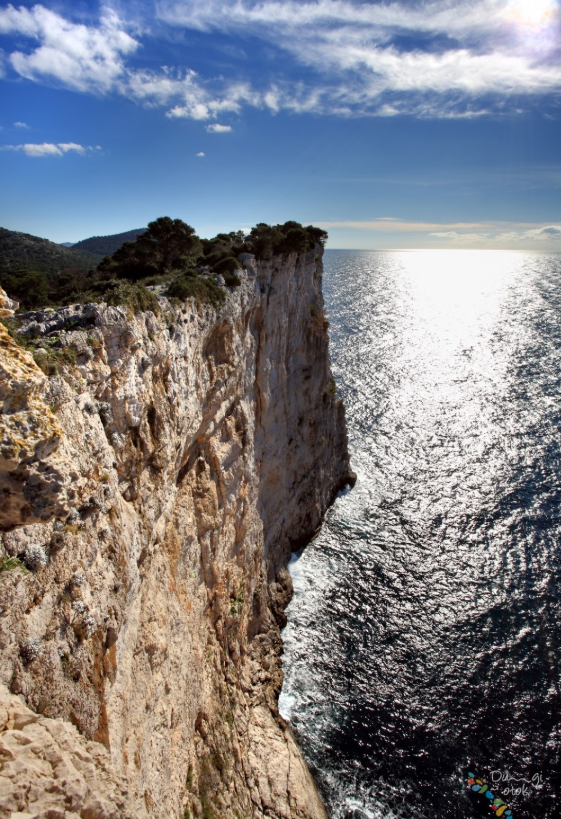
Cliffs outside of Telaščica bay at Dugi Otok (source: DugiOtok.hr)
This will be another navigationally straightforward leg, so my advice is: wake up early, motor off immediately, and then enjoy your morning routine with the boat on autopilot.
Today you’ll experience first-hand how Dugi Otok earned its name—its direct translation is “Long Island”. And while it’s about four times shorter than its namesake across the Atlantic, it can still be a challenge to sail its full length in one day, especially in poor weather. But let’s assume Neptune’s in a good mood and you’re blessed with favourable conditions—plenty of wind and manageable waves. In that case, you’ll be perfectly positioned to enjoy the wild beauty of this sparsely populated island.
By the end of the day, you’ll reach the famous cliffs just outside Telaščica Bay. The waters in front of the cliffs are quite deep and safe, so you can get fairly close to admire them up close—just not too close, as the wind and waves, though gentle, are relentless.
Once you’ve filled your phone with enough cliffside photos, it’s time to decide where you’ll end the day.
Option 1
Levrnaka Restaurant, the only sign of civilisation on the small island of the same name, just at the entrance to Kornati National Park. The restaurant has a lovely, but not very large, pontoon—so it’s smart to call ahead and reserve a spot.
While you’re at it, also ask about the prices. They've always been on the high side, and in recent years, they’ve climbed even higher. Keep in mind: if you dock on their pontoon, you’ll be required to dine at the restaurant, so it’s best to budget for that in advance.
Option 2
Spend the night on the opposite side of Levrnaka, in front of the stunning Lojena Beach (also called Kravljačica on some maps). There are no buoys here, and as you’ll be exposed to open sea, you’ll need to be confident in your anchoring skills.
Fortunately, the seabed is mostly sand, and the anchor should hold well unless the weather takes a turn. Lojena is a must-visit, whether you anchor here or stop at the restaurant—the turquoise water is every bit as breathtaking as the photos you’ll have seen online.
Option 3
Sail north through the narrow strait Mala Proversa (“Small Passage”) and head to the beautiful town of Sali, on the opposite side of Dugi Otok. Sali is a fair bit larger than Veli Iž but still retains the charm of a small island village, with plenty to explore.
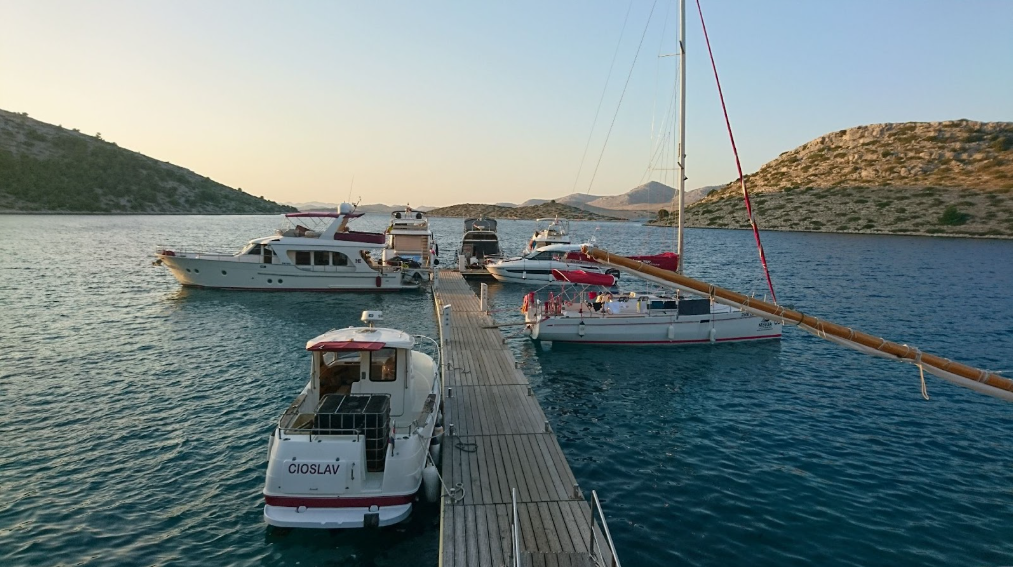
The pontoon in front of the restaurant at Levrnaka is small and fills up quickly (source: private archive)
If possible, dock on the northern side of the bay, where you’ll find most of the infrastructure and interesting spots. If you’re a reader, don’t miss the public library, where you can borrow a book and return it on your next visit (and there’s a good chance you will come back).
If your timing is right and there’s a festival going on, don’t miss the chance to see genuine local acts like Tovareća mužika (ethno) or Fish Factory (old-school punk).
Either way, it’s almost impossible to be bored in Sali. Nor hungry, for that matter—there are plenty of restaurants of all kinds.
And if there are early birds in your crew, they can buy fresh fish straight from the local fishermen the next morning (Sali has a strong fishing tradition, and the boats return to port around 6 AM).
Day 5: Through Kornati National Park
Distance: 13 NM
After the two longest legs, today brings the shortest leg of the Grand Tour—but, according to many (myself included), also the most beautiful. You’ll be sailing right through one of Croatia’s eight national parks—Kornati National Park—so take it slow and soak it all in.
And if you just can’t get enough of sailing, feel free to stray from the suggested straight route and zig-zag between the many small, uninhabited islands along the way—crystal-clear water will be waiting for you wherever you go.
Just remember that you’re in a protected area, and there are specific rules of conduct you need to follow.
Also, unlike most of the Adriatic—where every rock or shallow patch is marked with cardinal signs—in Kornati there are a few hazards that aren’t marked at all. So be extra careful when plotting your course (check the end of this article for useful navigation resources).
When you’re done exploring, head towards one of the southernmost islands in the archipelago—Vela Smokvica—where you’ll find two restaurants, each with a few moorings. Just like at Levrnaka, it’s a good idea to call ahead, check prices (they shouldn’t be as high as Levrnaka), and reserve your spot.
Hint
Whichever way you ended Day 4, this leg will take you straight through Kornati National Park. An entrance fee is not required if you’re just sailing through without stopping.
But if you plan to anchor, moor, or go ashore anywhere in the park, then you are legally required to have a valid ticket.
So, unless you spent last night in Sali and are simply passing through today without stopping, you’ll need one. The cheapest way to get it is to buy it online in advance.
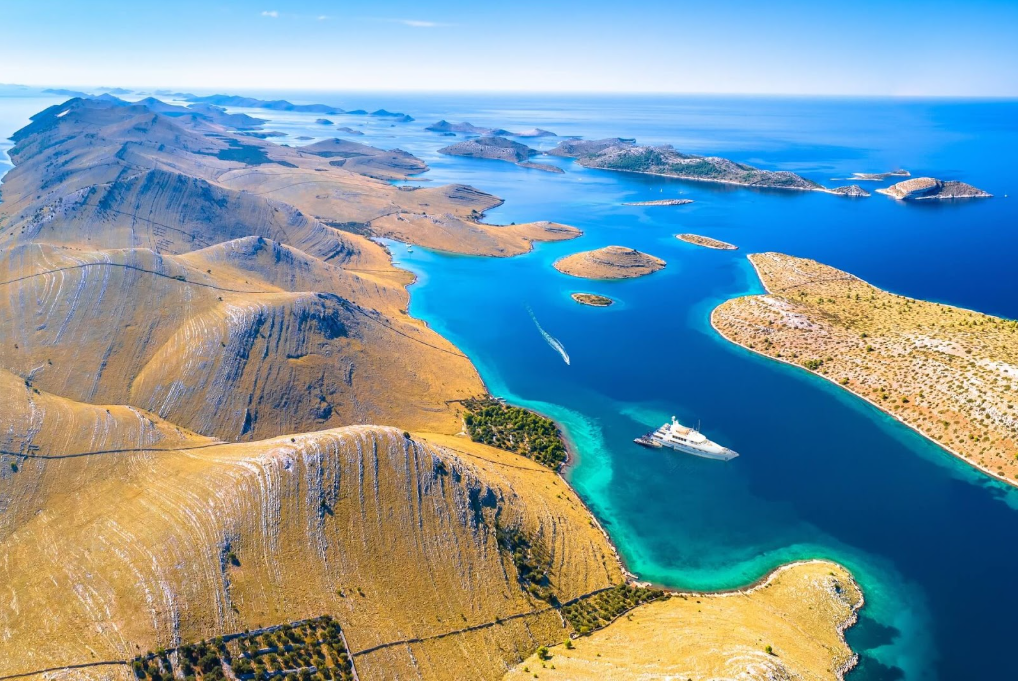
Kornati National Park (source: Kornati.hr)
Day 6: Back to Biograd… with a twist
Distance: 16 NM
On your final day, it’s time to start heading back to Biograd—so after leaving Smokvica, point your bow directly north. You’ll be sailing in open water, clear of any islands, which means there’s a good chance you’ll catch some nice winds along the way.
If you’ve had your fill of sailing, you can head straight for Biograd (and possibly beat the crowds at the petrol station). But my suggestion is to make one last stop—just south of the island Murvenjak—for a final swim and lunch at anchor.
It’s a great moment to polish off the rest of the supplies you brought with you a week ago (which by now will probably feel like they’ve been onboard since the Bronze Age).
There used to be an even better anchorage on the north side of Murvenjak (and some older guides may still recommend it), but these days there’s a tuna farm there.
That makes it tricky to navigate, harder to drop anchor, and not worth the effort—especially since sea quality near fish farms is usually nothing to write home about. So when you get to Murvenjak, stick to the south side.
Marina Kornati in Biograd is a busy charter hub, and since most companies ask for boats to be returned on Friday evening with a full tank, don’t be surprised to find a bit of a queue at the petrol station just outside the marina.
On the plus side, the marina is very well staffed—so no matter how late you arrive, someone will be there to help guide you to your dock, even if your charter company has already clocked off. Just call the marina team on VHF channel 17 and let them take care of your arrival.
Once you’re in and safely moored, you’ve got one final decision to make: head into town one last time and try a restaurant you missed at the start of the week, or stay onboard and finish up whatever’s left in the fridge. Both have their charms—so I’ll leave that one up to you.
Sleep on the boat one last time, and check out in the morning.
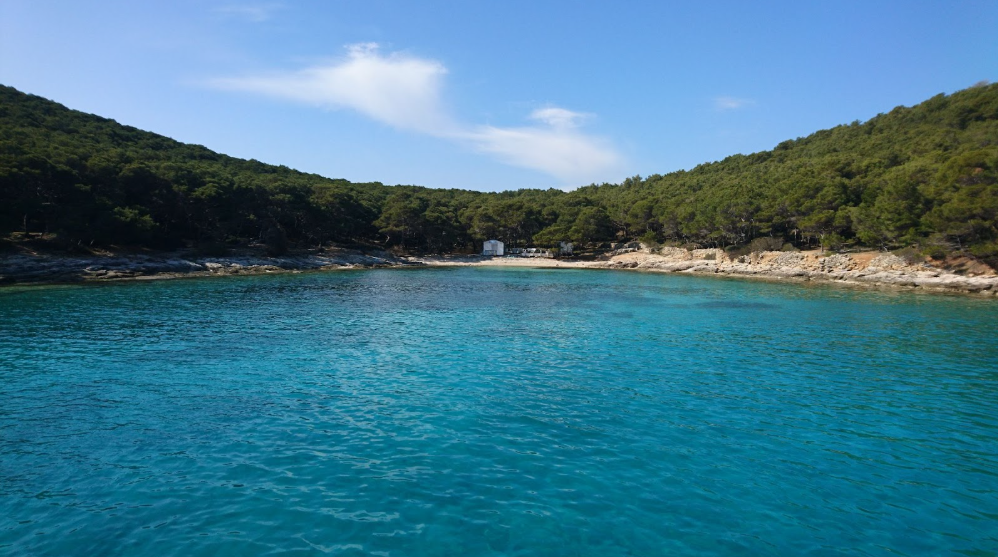
Tools & Resources
Although you can always sail old-school style, just using onboard paper maps and compass, getting the weather forecast via VHF, there's no reason not to leverage all the goodies of the 21st century. Here are a few.
Macrocruise: Worldwide charter search engine. Allows you to search for boats by many parameters.
Navionics Boating App: Marine charts with an excellent coverage of the Adriatic Sea. Especially useful are real-time reviews of anchorages, restaurants, and other resources coming from other users of the app (requires a working Internet connection). The map itself can be browsed for free on the web here so you can evaluate upfront if it's worth the money Garmin is asking for it.
nIS: Nautical Information Service offers weather forecasts and alerts (that you shouldn't ignore!). Completely free (it's sponsored by the Croatian government).
Windy: Various weather forecasts (wind, waves, rain, ...). More detailed than what nIS offers, but if those two are giving you colliding predictions, trust nIS.
Sim Local: eSIM plans to keep you connected (and thus safe!) while at sea. Both Navionics and nIS work best with a working Internet connection and Windy doesn't work without it at all.
Cash: Carry a decent amount of euros, as many of the places described in this article are remote and may not accept cards.
- Gordan Krešić is a part-time sailor and full-time Technical Lead at Sim Local.
Please note: These images are for illustrative purposes only and do not belong to us. All rights remain with their respective owners.
Related Articles
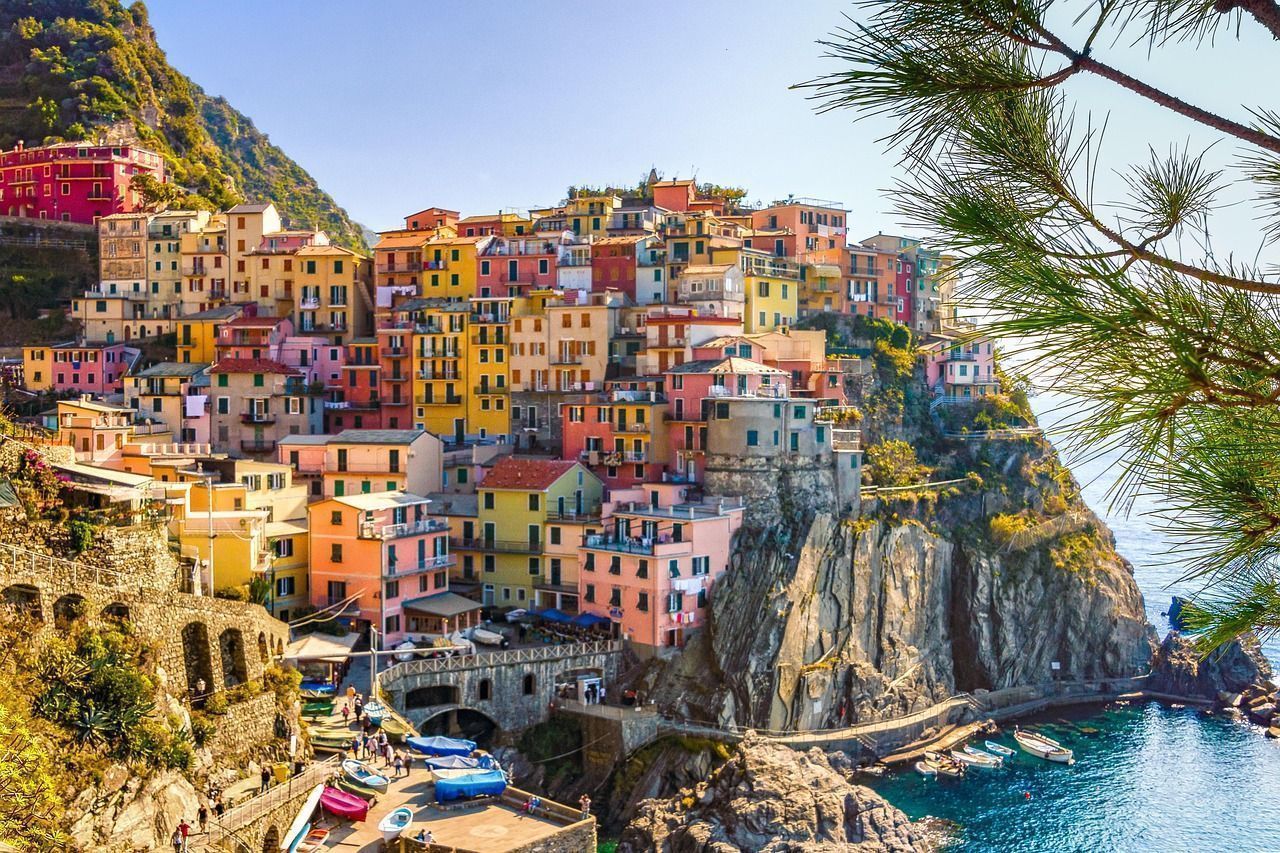 How to Buy the Best eSIM for Italy
How to Buy the Best eSIM for Italy Let's look at how easy it is to buy an eSIM for Italy in just 5 simple steps. This guide includes our current bestselling eSIMs for Italy.
Read More Best eSIMs for Travelling in Europe
Best eSIMs for Travelling in Europe Read through our top 6 eSIMs for travel in Europe and find out which Europe eSIM is perfect for your time in Europe.
Read More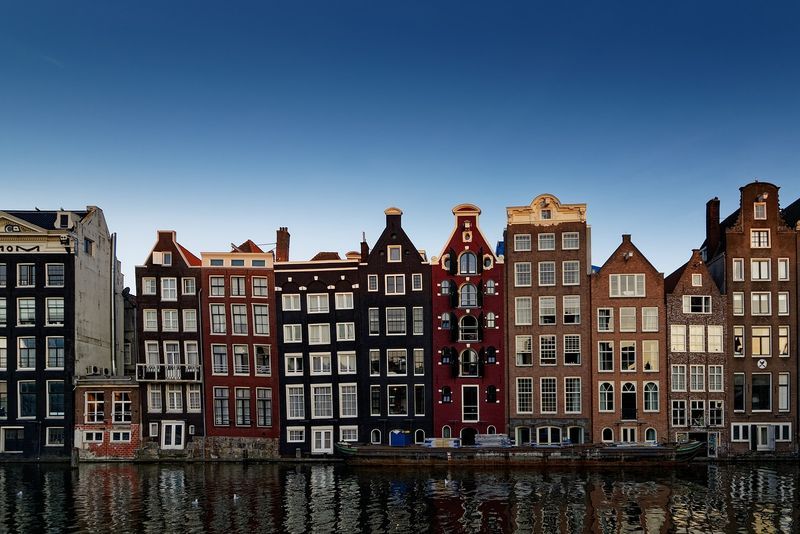 12 Most Walkable Cities in Europe
12 Most Walkable Cities in EuropeA handy guide to exploring some of Europe’s most iconic and historic spots that are easily explored on foot.
Read More